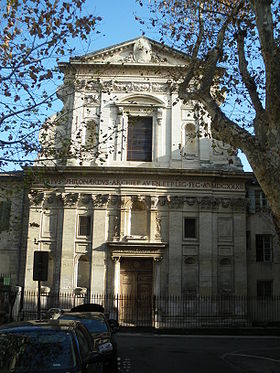
An obscure mystic of the Sacred Heart, a Visitandine, and a “foundress”, Rosalie Albaret, or Sister Teresa of Jesus, was born in France in January of 1743, the youngest of 10 children, and eventually entered the Visitation Monastery of Avignon.
Her dad was a Christian, but not Catholic, which caused Rosalie a bit of suffering as a child. She showed a precocity for virtue which was not typical of her young age. It is also said that when the Bishop anointed her with the holy oil at Confirmation, he saw a dove descend on her head, a pure and living image of the one who took possession of Rosalie forever.
The moment arrived when her education was finished,so she left the Ursulines to go to Limoux with the Sisters of Charity. Her stay was not long; after eight months she had to part with it, she returned to Mont- pellier, where she was assured of the protection of the Bishop, and spent several years there. There, whatever the vicissitudes of her outer life, the orientation of her soul towards God remained the same, and the supernatural remained her element.
Being well known to the Bishop, he encouraged Rosalie to join the Visitation Order and it was Mother Marie-Séraphique Olivier welcomed her on July 1, 1771.
On the 21st of July, 1772. Jesus condescended to appear to her ; he took her heart and returned it to her with four crosses which He had engraved himself. The first represented the acute pains she would have to endure throughout the body, the second the sorrows of spirit and extraordinary temptations, the third the fear that she would have in thinking she was spiritually deceived and the fourth, finally, the general struggles. She accepted these crosses as the gift of her engagement, and declared herself ready to receive all those which it would please her Jesus to give her . “:
The Ceremony of clothing with the habit took place the next day, at 4 o’clock. in the morning. They had chosen this early hour to escape the eagerness of the crowd that held Rosalie for a saint. At the same time that she received the habit of the Daughters of St. Francis de Sales, she took the name of Sister Thérèse of Jesus.
The crucifixion which the Savior had foretold to her was not long in coming. Less than two months after taking her habit, she found herself in such deep inner desolation that the anguish with which her soul was tortured was painted outside in an expression of indescribable sadness. She was truly pitiful. His sweet love came to her aid. As she was bedridden by rheumatic pains, she was hungry and thirsty for Holy Communion. On September 4, Jesus appeared to her carrying a host in his hand. Burning sparks came out of the Sacred Heart, and Therese of Jesus was all in flames. At that very instant, the darkness which darkened her soul was dissipated, and Jesus wished to give himself to her by offering her the host But she refused it, and in the fear that she might be the plaything of a devil’s artifice, she did not even kneel to worship. – “My Daughter,” said Our Lord, “your distrust did not displease me, but I do not want you to doubt any longer the power of my love;” and at the same moment, without opening her mouth he communicated it. Sr. Therese of Jesus felt the torrent of Divine Love that filled her soul.
It is to be noted that after her profession, she no longer had to suffer external attacks from the devil. As for the extraordinary favors which came to her from heaven, she continued to enjoy them, but tempered in such a way that they did not hinder her activity in the different jobs entrusted to her solicitude.
She was successively Mistress of the boarders, Portress of the Convent and Mistress of the novices. When she received this last charge, it was thought she was like St Margaret Mary. She had the same zeal for the good of souls, the same intelligence of supernatural ways, the same union with God, the same love of Jesus.
When the French Revolution came , Sister Teresa entered Spain with several of her companions, and after many vicissitudes came to settle at Saragossa, where she remained for eight years; and from there she left to found the House of Calatayud with 12 nuns of France. She was still in Saragossa when she had, in 1799, a revelation about the destinies of Spain.
We know almost nothing of the last years of her life and we do not know the date of her death. For the last two years, sores on the heels had been causing her pain and confinement to her room. For some time she was brought down to the chapel every day for communion. Six months before she died, she stopped being transportable. Holy Communion was brought to her on Sundays and feast days. These were good days. The edification she had built up in her homeland sustained herself in exile until her last moments. She seemed utterly lost in God, equally indifferent to life and death. She expired, having kept up to the end full knowledge and in perfect serenity. –